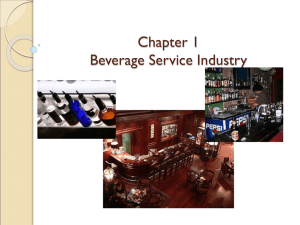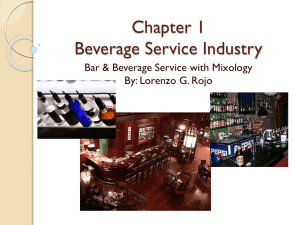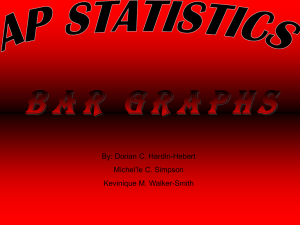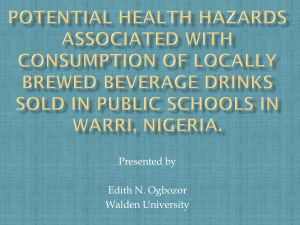Chapter 1 Beverage Service Industry An Introduction
advertisement
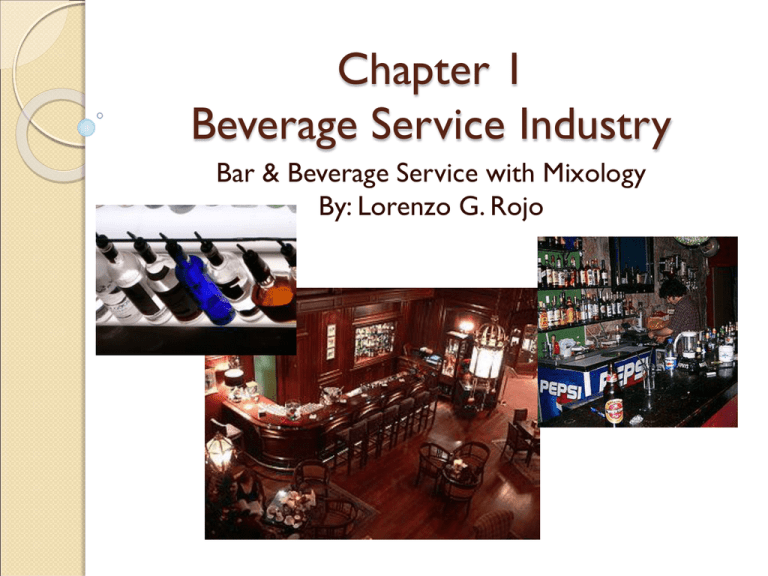
Chapter 1 Beverage Service Industry Bar & Beverage Service with Mixology By: Lorenzo G. Rojo Definition: Beverage Service Industry – comprises of establishments or businesses that offer primarily beverages, foods and sometimes entertainment and other services. Bars – are establishments or businesses that primarily offer beverages, food and sometimes entertainment and other services to its customers. History: Ancient Sumeria / Sumer 4000 BC Sumerians were considered the most progressive group of people. Some part of Sumer is the present Iraq. ◦ Sumerians were skilled traders, farmers and craftsmen. ◦ invented the wheel (potter’s wheel), ◦ cuneiform writing system ◦ first astronomers, ◦ arithmetic, ◦ military formations and introduced the basic divisions between infantry, cavalry and archers ◦ first true city states, ◦ intensive agriculture and irrigation. In the Middle East, one of the problems is the availability of potable water. Sumerians also encountered this problem. In order to solve this problem, they tried to come up with alternative drinking liquid particularly derived from fermented cereal grains. Thus, ale was created which is today’s beer. Some Sumerians produced more ale not only for themselves, but also for others who could not produce their own and this led to the establishment of the forerunner of today’s bar, the tavern. Taverns – were places serving beverage particularly “ale” and places for social gatherings. ◦ Derived from the Latin term taberna and the Greek taverna, whose original meaning was a shed or workshop. ◦ Taverns have existed in England as early as the 13th century and were often kept by women usually known as ale-wives. ◦ By the 19th century in England, the word tavern had evolved, from tavern to public house (pub). Empire Era 3200 – AD 476 Ancient Egypt As a proof that taverns continued to exist after the time of Sumerians, a papyrus was discovered from ancient Egypt which contained some warnings that says “do not get drunk in taverns . . . For fear that people repeat words which may have gone out of your mouth without you being aware of having uttered them.” ◦ An indication that early people already knows the effects of alcohol to the body and mind. Ancient Greece 1100 BC As time passed by, taverns continued to exist and develops. One of the reasons was due to the increase in the number of people who travelled. Greeks travel for religion, sports or games and to conquer lands. During the time of the Greeks, places for the rich and the poor existed. Establishments serving foods and beverages includes Lesches – serving fine food and drinks for the rich, and Taverns – places for the poor. Ancient Rome 500 BC – 476 AD Aqueducts After the Romans succeeded the Greeks, Romans conquered almost all parts of Europe. During their time, the reasons for travel continued to increase and this was due to the development of transportation particularly on the constructions of roads and bridges. As more people travelled, the number of places serving food and drinks also increased. Romans travel for trade, religion, pleasure or relaxation, and for political reasons. In the city of Pompei, 118 bar or taverns were discovered. Decline and Revival AD 476 – AD 1300 After the fall of the Roman Empire, life went back to its primitive way. Travel and tourism whether for business or pleasure virtually ceased. Decline and Revival (AD 476 – AD 1300), travel and tourism ceased and primarily travel became limited for religious purposes only. The church through its monasteries, took over the job of feeding and housing the travelers. They created xenodocheions or a place to house travelers which means an inn. Renaissance AD 1350 – AD 1600 Some degree of safety had returned to the roads, one of the critical element in the development of the industry. Trade and travel increased. The middle class became a dominant force in the economic life of Europe. Ale house or taverns reappeared along trade routes. Early Modern AD 1600 – AD 1800 The development of roads was one of the critical elements in the development of the beverage service industry. the introduction of stagecoaches became the means of transportation. Post houses were built along stagecoach routes and serve as a place for food and drinks and accommodation for the traveler. It was also where tired horses changed for fresh horses to continue a fast travel. Post houses are the equivalent of today’s gasoline stations. The Industrial Era From 1800 The industrial revolution started in England around 1800, it was the time when machines were invented. Invention of Invented machines were ran by steam and were locomotive used for productions and transportation. Development of rail travel which made a great impact in travel. In entire Europe, taverns became a permanent establishment. Growth of Factory System In England, taverns were known as public houses or pub houses or pubs, a place for pleasure and worship. Man viewed as part of machines Other versions of taverns all through out Europe: ◦ Inns – are establishments where travelers can procure food, drink and lodging. ◦ Pubs – are an establishment which serves alcoholic drinks especially beer for consumption on the premises, usually in a homely setting. Pubs are commonly found in Englishspeaking countries, particularly in the United Kingdom, Ireland, Canada, Australia and New Zealand. ◦ Cabarets – are restaurants or nightclubs with a stage for performances and the audience sitting around the tables (often dining or drinking) watching the performance. Today, cabaret is commonly known as a show, often can be seen in entertainment centers or areas like Las Vegas. American Taverns ◦ Taverns in America were introduced by the British. ◦ The distinction between the British and the American taverns was the inclusion of accommodation and entertainment. ◦ The entertainments in American taverns were in the forms of gambling and prostitution. ◦ The Philippine bars are patterned to American bars or taverns. ◦ 1643 – the beginning of American Beverage Service Industry. ◦ Coles Ordinary – the 1st American tavern. ◦ Taverns served as a place or rendezvous for revolutionaries before the war. ◦ In Massachusetts 1656, a town without a tavern was penalized, taverns were built near the church. ◦ The reason why taverns were built near the church is because during this time there were still no heaters in buildings that could minimize the cold temperature during winter. So after the worship service, people went to taverns to warm their body by drinking alcoholic beverage at the same time the leaders of community discussed matters of the community. Queens Head or Fraunces Tavern, 54 Pearl st cor Broad st NYC Green Dragon Tavern, 11 Marshall St Boston, MA 02108 Early American Taverns: ◦ ◦ ◦ ◦ Hancock Tavern Green Dragon Raleigh Tavern Queens Head or Fraunces Tavern Raleigh Tavern, Colonial Williamsburg Hancock Tavern, 668 Hancock Street, Quincy, MA 02170 In 1850 – taverns became large scale inns and later it became hotels. They were designed like a palace but open for public use. In 1920 – Prohibition Law or 18th Amendment Law was passed – this made manufacturing, selling, and importation of alcoholic beverage in America illegal. The Prohibition Law caused large numbers of establishments stopped to operate, people lost their jobs and the government lost a large amount of revenue from the taxes generated from those establishments, and made known as a major cause of The Great American Depression. Speakeasies – places that sold illegal liquors for the rich Americans and blind pigs for the poor. Moonshines – term used for illegal liquors produced during night time. Bootleggers – illegal suppliers of illegal liquors. They were known as bootleggers because they started to smuggle illegal alcoholic beverages in flask by concealing it in their boots. Bathtub Gin – Gin made in the bathtub, because the preferred style of bottle didn't fit in the kitchen sink. Rumrunners – alcohol smugglers On 1933, the 21st Amendment was passed to repeal the Prohibition Law. Dramshop Law or Third Party Liability Law – this law shifted the liability for damages in the drunken driven incident from the driver who caused the accident to the server or the place that served the drink to the driver. Dram – means small drink Shop – the place that serves the drinks. P-Noy signs law vs drunk driving By Delon Porcalla (The Philippine Star) May 31, 2013 President Aquino has signed into law a measure that would penalize drivers found to be driving under the influence of liquor or prohibited drugs with up to three months in prison and a fine ranging from Php20,000.00 Php80,000.00 Republic Act 10586 or the “Anti-Drunk and Drugged Driving Act of 2013” also imposes harsher penalties in cases of drunk or drugged drivers getting involved in accidents, especially if there are casualties. There will be a maximum fine ranging from Php100,000.00 to Php200,000.00 for physical injuries incurred in accidents, and P500,000 if such collision resulted in somebody’s death. Aside from these, the Land Transportation Office shall confiscate and suspend for 12 months the license of a non-professional driver for the first conviction. On second conviction the license would be perpetually revoked. For professional drivers, their license would be confiscated and perpetually revoked for the first conviction, which shall be the basis to disqualify the driver from “being granted any kind of driver’s license thereafter.” Refusal to comply with mandatory tests for field sobriety and drug tests will result in confiscation and automatic revocation of license, aside from “other penalties provided and/or other pertinent laws.” The owner and/or operator of the offending vehicle, in case of vehicles for hire, will be just as “directly and principally (held) liable together with the offender for the fine and the award against the offender for civil damages.” However, the operator of the vehicles for rent may be exculpated if he “has exercised extraordinary diligence in the selection and supervision of his drivers in general and the offending driver in particular.” “Section 7 now mandates the mandatory alcohol and chemical testing of drivers involved in motor vehicular accidents, so that will now be a staple,” Valte told a news briefing in Malacanang, adding that a breathalyzer would be used to verify alcohol or drug consumption. Development of Beverage Industry in the Philippines The San Miguel Corporation ◦ 1890 – founded by Don Enrique Maria Barreto de Ycaza in San Miguel district in Manila, the La Fabrica de Cerveza de San Miguel, the first brewery in South East Asia. ◦ 1913 – it became a corporation and began exporting beer in Guam, Hong Kong and Shanghai. ◦ 1922 – the year which started producing soft drinks at the Royal Soft Drinks Plant. 1925 – the year that started producing ice cream at the Magnolia ice Cream Plant. 1927 – the year that started bottling of Coca Cola in the Philippines. 1938 – entered the glass industry, supplying the company’s bottling needs. 1963 – San Miguel Brewery was renamed San Miguel Corporation; the largest food, beverage and packaging company in the Philippines. Board of Directors, SMG Corp. Eduardo M. Cojuangco, Jr. Chairman and CEO Ramon S. Ang, President and COO Estelito P. Mendoza, Member of the Board Inigo Zobel, Member of the Board Winston F. Garcia, Member of the Board Menardo R. Jimenez , Member of the Board Leo S. Alvez, Member of the Board Egmidio de Silva Jose , Member of the Board Pacifico M. Fajardo , Member of the Board Jesusa Victoria Hernandez-Bautista, Member of the Board Hector L. Hofileña , Member of the Board Carmelo L. Santiago , Member of the Board Roberto V. Ongpin, Member of the Board Mirzan Mahathir, Member of the Board Alexander J. Poblador , Member of the Board Today’s Beverage Service Industry The term “bar” is the most common term used in the US and in the Philippines indicating a beverage service establishment. The term bar was derived from the French term “barre” which means a counter. The term bar was first used around 1592 and bars were used before in railway stations as a counter used to dispense the food faster to passengers. The first bar that served alcoholic beverage was the Great Western Hotel on Paddington station, London. The Type of Today’s Beverage Service Industry 1. Beverage-only Bar • It served beverage alone. No food was served beyond snacks. • This type of bar was usually located near terminals or stations. 2. Bar / Entertainment Combination • Bars offering drinks and a range of entertainment. • Types of entertainment: Dancing / Disco / Ballroom Internet Singing / videoke Sports Live performances Types of Bar/Entertainment Combination: ◦ Disco bars – are type of bars where dancing (disco) is the form of entertainment and the guest could have both food and drinks and dance. ◦ Nightclubs – are drinking, dancing, and entertainment venue which do its primary business after dark. A nightclub can be distinguished from other forms of such as bars, pubs, or taverns, by the inclusion of a dance floor and a DJ booth, where a DJ plays recoded dance and pop music. Some nightclubs have other forms of entertainment, such as comedians, “go-go” dancers, a floor show or strippers. Internet café or cybercafe – is a place where one can use a computer with internet access for a fee, usually per hour or minute charge; sometimes one can have unmetered access with a pass for a day or month. It may or may not serve as a regular café as well, with food and drinks being served. Videoke bars – a very popular form of bar and entertainment where guests are the ones singing or performing. Sports bar / pool bars – pool or other sports and watching sports events are the main entertainment offered in this type of bar. Comedy bars – a type of entertainment bar where stand up comedians performs to entertain the guest while having their drinks and foods. Gay bars – this is the opposite of KTV bars but this time patrons are gays and older women or widower looking for a different kind of entertainment similar to KTV bars. KTV bars – are modern concept of night clubs. Entertainment is in the form of videoke and live performances of strip teasers or gogo dancers. Individual entertainers known as Guest Relation Officers or commonly known as GROs are available upon the guest request. This GROs are housed in a room with one way glass window and they are numbered for easy selection of guest. They can be tabled in the common guest area or in a VIP room alone with the guest with videoke as the main entertainment. Food and Beverage Combination • It serves food with beverage usually linked with some kind of food service. • Types: ◦ Bar and Restaurant ◦ Tea houses / Tea Rooms ◦ Taverns ◦ Public House / Pubs ◦ Brew pubs / Micro Breweries ◦ Service Bars Bar and Restaurant – this type of bar, food and drink can be served at the same time or the guest can have a drink first before dining or dine first before drinking. Tea houses / Tea rooms – a small room or restaurant where beverages and light meals are served, often catering chiefly to women and having a sedate or subdued atmosphere. It also serves as place for business transactions. Public houses / Pubs – are a drinking establishments which serve alcoholic drinks especially beer that can be consumed on the premises, usually with a set up like home. Also known as another home away from home. Here are some of the descriptions of pubs in London and in other places: ◦ Beers served in a pub may be cask ales or keg beers. ◦ Traditionally the windows of town pubs are of smoked or frosted glass so that the clientele are obscured from the street to have some privacy. ◦ The owner, tenant or manager of a public house is known as the publican or landlord ◦ Each pub generally has a crowd of regulars, people who drink there regularly. ◦ The pub that people most often is called their local. Taverns – is a place of business where people gather to drink alcoholic beverages and, more likely, food is also served. Today, it is an outdoor type with shed or tent covering the entire place. Brew pubs / Micro Breweries – are pubs or restaurants that brew beer in their premises. Service bars – these bars are in restaurants only used to prepare drinks of the dining guests. Hotel Beverage Operation • Three or more bars in one roof with different purpose and ambience. Usually the types of bars that can be found inside the hotel are both bar-entertainment and food and beverage combination bars. Types of bars in hotels: ◦ ◦ ◦ ◦ ◦ ◦ ◦ ◦ ◦ Lobby Bar Coffee Shop Cocktail Lounge / Piano Bar Restaurant Bar / Service Bar Disco Bar / Night Club Videoke Bar Poolside Bar / Pool Bar Pool / Sports Bar Banquet Bar Open Bar Set up Limited Bar Set up ◦ Mini Bar Lobby bar – the bar located at the lobby area of the hotel, it is usually used by the guest as a venue for business meetings or transactions during night time. In some hotels, it is also considered as the main bar. Coffee shop – mostly located in the lobby or near the lobby area where both food and drinks can be served to the guests, particularly coffee. It is usually used by the guest as a place for business meeting or transactions. Cocktail lounge / Piano bar – this is where live or piano music is performed. Guests stay here to relax or to unwind. Restaurant bar / Service bar – the bar is used to prepare drinks of the dining guest. Disco bar / Night club - where dancing (disco) is the form of entertainment or the guest could have both food and drinks and dance. Videoke bar – a very popular form of bar and entertainment where the guests are the one performing. Poolside / Pool bar – bar located at the poolside. Guest can take a drink after or during swimming to ease the thirst and also to provide some warmth during colder season. Pool / Sports bar – pool or other sports and watching sports events is the main entertainment offer in this type of bar in a hotel. Banquet bar – a bar being set up during functions or events in the banquet or meeting rooms in the hotel to provide / serve drinks to the guest of the event or function. ◦ Banquet bar set-up: Open bar set-up - the guest can order any drinks available in the bar or the main bar of the hotel. But usually the guest will be the one to pay the bill not the host of the event or function. Limited bar set-up – only the drinks allowed by the host will be served to the guests of the function or the event. Mini-bar – a bar in a guest room for guests’ convenience. Alcoholic drinks in mini-bar are usually in a miniature size bottle to ensure proper inventory of the drinks after the guest have checked out. Usually it is a minirefrigerator where beverages both alcoholic and non-alcoholic are stored. Airline Beverage Service • Bars in commercial passenger planes serving drinks to the passengers. Usually the bar can be found in the business class section of the plane. For those passengers in the economy class if they ordered a drink or a shot drink, it is usually served in miniature size bottle together with a glass where the drink will be served. For mixed drink, it is served mixed already. Cruise and passenger ship beverage service • Serving passengers in a cruise and passenger ship. Particularly in cruise types of bars that can be found are also similar to those in hotel operations since it is either a floating hotel, resort, theme park like those of the Royal Carribean Cruises. Rail beverage service - Bars in commercial passenger rails serving drinks to the passengers. Coffee shops/ Coffee Houses/ Café – a place specializing on coffee and serves as a meeting place particularly for transacting business. Beer Garden – is an open-air public area where alcohol is legally served. In Germany, beer garden is common place particularly during the famous October Fest. The End
